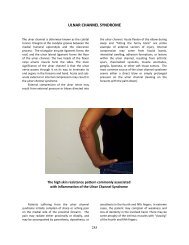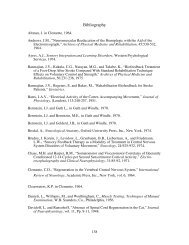SHOULDER-HAND SYNDROME - Advtherapy.net
SHOULDER-HAND SYNDROME - Advtherapy.net
SHOULDER-HAND SYNDROME - Advtherapy.net
- No tags were found...
Create successful ePaper yourself
Turn your PDF publications into a flip-book with our unique Google optimized e-Paper software.
<strong>SHOULDER</strong>‐<strong>HAND</strong> <strong>SYNDROME</strong>The shoulder‐hand syndrome generally develops as areflex dystrophy with accompanying causalgia,characterized by pain in the shoulder. This is alsoassociated with swelling and pain in the hand, on theinvolved side. Changes in the shoulder joint areidentical with those seen in the frozen shouldersyndrome. It is thought by some to be amanifestation of reflex sympathetic dystrophy thatmay follow any painful shoulder lesion, but it hasalso been noted to arise as incidental sequelae ofmyocardial infarction, pleurisy, various kinds ofpainful intrathoracic lesions, cerebrovascularaccidents, trauma, rupture of a cervical disc, orcervical arthritis.The shoulder‐hand syndrome begins to emergeas the patient persists in keeping the shoulder andshoulder girdle immobile. Disuse of the involvedmuscles brings on a progressively painful stiffshoulder. Uniform edematous swelling of the handbegins to develop and finger joint motion becomesprogressively limited. The mechanism postulated tobe responsible is a reflex‐like response to painsensation by sympathetic nerves, whichcommunicate with the involved sensory nerve in theinternuncial pool in the spinal cord. The sympatheticnerves respond to the distally occurring pain bytriggering a reflexive efferent reactive vasomotoraction in the involved region. This effectivelyreduces blood circulation to the tissues perceived tobe involved in the pain pattern.The changes in the hand brought on by theshoulder‐hand syndrome progress in three stages:(1) the patient complains of a burning pain in thehand, which is coincidentally either cold and clammyor cold, red, moist, stiff and superficially sensitive totouch or pressure; (2) the hand appears white andcreaseless, the skin thickened, and the hand isincreasingly cold and stiff; (3) the hand appears paleand thin, and there is muscular atrophy (guttering)with contractures of the joints (osteoporosis maybecome evident with x‐ray). At the end of thisprocess the hand and arm is generally useless andnonfunctional.TreatmentTreatment of the shoulder‐hand syndrome centersaround relieving the provocative cause (ifascertainable), increasing peripheral circulation,eliminating any inflammatory process, regaining lostmuscle strength, relieving myogenic pain andencouraging motion of the hand and shoulder. Softtissue manipulation (adhesion breaking), and jointmanipulation and stretching may be necessary torecover lost ranges of motion.It should be noted that electrical stimulation,when applied appropriately, may be used to increasecapillary density in the involved extremity, andtherefore should be effective for reversing thevascular component of the syndrome, even late inthe game.Application:If muscle atrophy is present, preset anelectrical stimulator to deliver a mediumfrequency current with a 10‐second on, 10‐second off duty cycle. Place a negativeelectrode over the triceps or biceps musclegroup and a positive electrode over thewrist extensor or wrist flexor muscle group.Increase the stimulator amplitude to thepoint that near tetanic contractions occur inthe muscle groups stimulated. For besttoning effects, have the elbow and wristjoints held in position to resist the force ofthe muscular contractions produced by thestimulator. Stimulate 10 minutes.To increase capillary density, and therebycapillary circulation, preset the stimulatorto produce a 7 Hz, wide‐pulsed galvaniccurrent and stimulate for 20 minutes.Adjust the amplitude to a point high enoughto produce visible rhythmic contractions inthe muscles stimulated (the joints may befree to move).Treatment sessions should occur severaltimes a week for several weeks. To double thecapillary bed density, daily sessions of the pulsedelectrical stimulation should continue for a month.Trigger PointsThe following trigger point formations may, singly orin combination, refer pain into the area of the259
shoulder, arm or hand: Levator scapulae, Scalenus,Scalenus (minimus), Infraspinatus, Infraspinatus(abnormal), Medial teres major, Lateral teres major,Teres minor, Coracobrachialis, Lower spleniuscervicis, Upper trapezius [B], Middle trapezius [A],Middle trapezius [B], Middle trapezius [C], Lowertrapezius [A], Cervical multifidus (C4‐C5),Supraspinatus (muscle), Supraspinatus (tendon),Latissimus dorsi (upper portion), Serratus posteriorsuperior, Serratus anterior, Subclavius,Subscapularis, Posterior deltoid, Anterior deltoid,Pectoralis major, Pectoralis major (sternal portion),Pectoralis minor, Sternalis, Rhomboids, Medialtriceps (deep fibers), Medial triceps (lateral fibers),Lateral triceps, Triceps (long head), Distal medialtriceps, Anconeus, Biceps brachii, Brachialis,Supinator, Extensor carpi radialis brevis, Extensorcarpi ulnaris, Middle finger extensor, Ring fingerextensor, Palmaris longus, Flexor carpi radialis,Flexor carpi ulnaris, Brachioradialis, Pronator teres,Extensor indicis, Flexor digitorum sublimis (radialhead), Flexor digitorum sublimis (humeral head),Flexor pollicis longus, Abductor digiti minimi, Seconddorsal interosseus, Opponens pollicis, Adductorpollicis, First dorsal interosseus, Multifidus (T4‐T5),Iliocostalis thoracis (T6), Iliocostalis thoracis (T11),and Extensor carpi radialis longus.260






